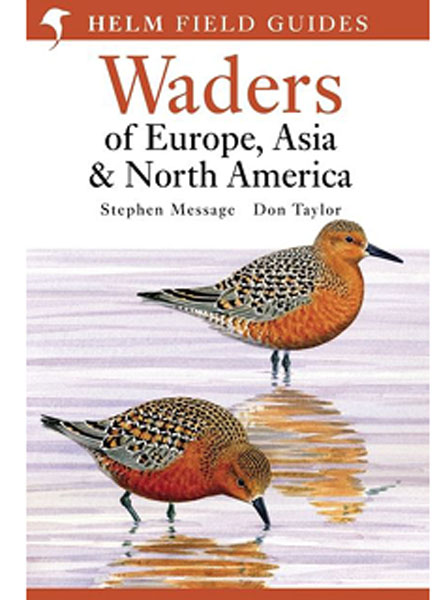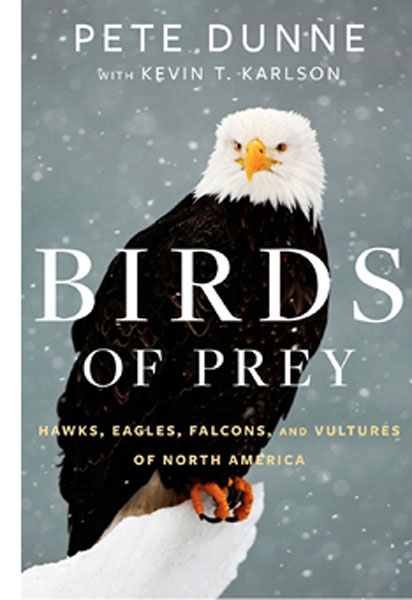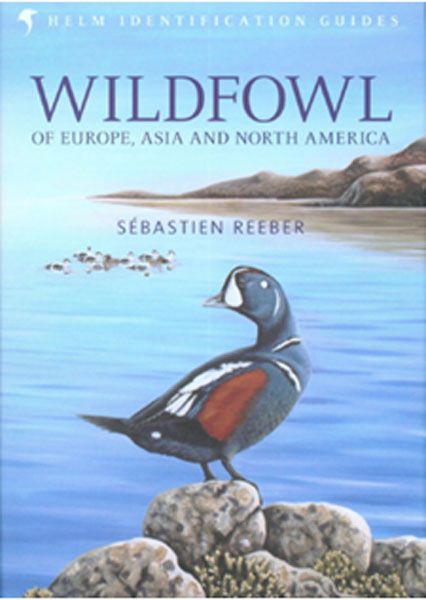Mark Lynch
Waders of Europe, Asia, and North America. Stephen Message and Don Taylor. 2016. London: Christopher Helm.
Shorebirds in Action: An Introduction to Waders and Their Behavior. Richard Chandler. 2017. Dunbeath, Scotland, United Kingdom: Whittles Publishing.
Birds of Prey: Hawks, Eagles, Falcons, and Vultures of North America. Pete Dunne with Kevin T. Karlson. 2016. New York: Houghton Mifflin Harcourt.
Wildfowl of Europe, Asia and North America. Sébastien Reeber. 2015 (English Edition). London: Bloomsbury.
The following are four "guides with a difference." Every serious birder would enjoy owning them all. You may already have one or two in your library, or you may want to start dropping hints for presents.
The scope and range of field guides have gone through an interesting evolution in the last thirty or more years. Early guides to the birds of a particular country sometimes split their coverage into two books: "land birds" and "water birds." The latter included herons, waterfowl, shorebirds, and gulls. Later regional guides included all the birds in one country but concentrated on the essential identification characteristics as well as range maps. Details on species behavior were few or non-existent unless they helped identify the species. The mid-eighties saw the publication of massive "identification guides," which were large books that gave limited identification specifics to all the birds in a world family or group. These were of particular interest to world birders. In the last fifteen years, the pendulum has swung back to a narrower geographical focus, books on single families or groups of birds. Now you find guides to the raptors of North America or the shorebirds of Europe. These new guides offer more in-depth identification information as well as more detail on behavior, range, and occurrence than a typical field guide.

The Waders of Europe, Asia, and North America is an interesting variation on this theme. The focus is on one order of birds but includes only those found in the Northern Hemisphere. This is useful for the hard-core birder because some of the most sought after species of shorebirds are those from continents other than our own. Good examples would be a Semipalmated Sandpiper found in Britain or a Ringed Plover in Massachusetts.
This compact book is almost a pocket guide, trim and lightweight and perfect to keep in your car's book box. You can easily put it in a backpack. Each species is fully illustrated in several plumages, and the text is opposite the plates. Similar species are featured on adjacent pages. Species descriptions include notes on key identification features, behavior, habitat, plumage, racial variations, and "confusion species." A special end section (p. 127–202) features illustrations and written descriptions of the species in flight.
This title is part of the Helm Field Guide Series. First published in 2005, this is the latest version. Although it doesn't include all the fine identification points, it does cover the basics and is a good reference if you think you have found a Little Stint on South Beach.

"What is the particular appeal of shorebirds? This book attempts to answer that question."
(p. v, Shorebirds in Action)
Richard Chandler is well known as a photographer and as an author of several key books on shorebirds. He has been a photographic consultant to British Birds and a member of its editorial board. Shorebirds in Action is nothing less than a college level course on world shorebird behavior by one of the experts in the field. It is beautifully illustrated with Chandler's own photographs. The photography is excellent, with many outstanding shots. These photos show 80% of the world's species of shorebirds, yet this soft-covered book is light in weight.
Unlike almost all shorebird guides, the focus of this book is exclusively on shorebird lives and behavior. Though the photography will initially grab your attention, the text is genuinely interesting and often entertaining. It will certainly expand your enjoyment of Charadriiformes. Identification details are almost completely absent. The first 66 pages are devoted to a thorough overview of the order. The remaining chapters each tackle different aspects of shorebird behavior, including plumage and molt, plumage maintenance, breeding and territorial behavior, migration, and finally flocking, roosting, and predator avoidance. Each chapter is thoroughly referenced.
My only complaint, and it is a very minor one, is that the title of each chapter is a wee bit "cutesy." For instance, the chapter on plumage maintenance is titled "When ah itchez, ah scratchez" (p. 146). I am sure this is intended to make the book less boring and more fun, but I personally have a low tolerance for cute. Luckily, the rest of the text moves right along. And then there are those photographs to enjoy!
Shorebirds in Action is a unique book that presents an overview of charadriiform behavior illustrated by the author's own photography. It doesn't matter if you live near the shore and sift through vast flocks of peeps on a regular basis or if you are content mostly to watch the breeding Spotted Sandpipers and Killdeers of your inland patch. You will find a lot to enjoy in Shorebirds in Action.

Pete Dunne has been enjoying and writing about raptors for decades. His writing style is enthusiastic, informative, and chatty. Team him up with the wonderful photography of Kevin T. Karlson, who shot many of the pictures in this book, and you have a "must own" account.
This book strives to offer a contemporary profile of North America's diurnal raptors. It was written to appeal to anyone who has ever been inspired by those magnificent birds and designed to compile in comprehensive fashion the biological particulars that distinguish and unite this bird group. (p. ix, Birds of Prey)
Now, before you taxonomic nitpickers get upset about Dunne's inclusion of New World vultures and falcons in a book about hawks and eagles, he answers your concerns this way: "Three compelling reasons: convention, convergence and convenience." (p. 3) But he quickly adds "Honesty compels me to admit that it is mostly convention that prompted me to take a broad and inclusive view when selecting the species to be covered in this book." (p. 5)
Of course, Dunne knows that "our" vultures belong on the list after the herons, and the falcons now follow the woodpeckers, but like many of us who have been birding for a while, we still think of them as part of a hawkwatch's tally.
Each species account includes notes on etymology, profile, a complete description, measurements, systematics and subspecies, breeding and behavior, and status. The text is lively and is fun to read. After all, this is a book by Pete Dunne. For instance, under the profile of the Hook-billed Kite. he describes the species like this: "A goofy-looking, bulbous-billed tree snail specialist that comports itself below the forest canopy in the manner of a feathered sloth." (p. 33)
Because of Dunne's many years studying raptors, he has lots of personal observations, many of which he shares with the reader. In the chapter on Osprey we read two accounts of Osprey-drowning lore:
Cape May resident Clay Sutton advises that his father, an avid fisherman, once secured a large bluefish that had two detached Osprey feet embedded in its back. It should be pointed out that feeding bluefish have a piranha-like quality and that, upon hitting the water, the bird was likely set upon by fish in the "blitzing" school. (p. 32)
Birds of Prey contains many personal anecdotes and observations like that, information you will not find in any typical field guide.
Superb photography is found throughout the book. Besides showing identification points to look for in the field, raptors are often shown behaving: diving, chasing prey, catching prey, being chased by other birds, or just looking cool. Birds of Prey sets a new standard for the quality and amount of photography in any guide; it is a high bar to surpass. This is a book to enjoy in many ways, including as a standard reference to the North American birds once collectively known as raptors.

As for Wildfowl, "The main aim is to summarize current knowledge concerning the specific and subspecific identification, ageing and sexing of the 83 species of geese, swans, and ducks found in Europe, Asia and North America." (p. 8, Wildfowl)
Unlike Birds of Prey, Wildfowl is not a fun-to-read book. Instead it is a thick, thorough, and always serious reference to what we in North America call "waterfowl." Because of that, it belongs on most birders' bookshelves and will likely be used to solve field problems more than the other three books discussed in this review. It is a book for field ornithologists as well as birders.
One of the initial titles in the Helm Identification Guide Series, the first Wildfowl was written by Steve Madge and Hilary Burn and was published in 1988. It included all the wildfowl of the world. This new Wildfowl is restricted only to those species found in the Northern Hemisphere. Even so, this book clocks in at 656 pages, whereas the original Wildfowl, of the world, mind you, ran only 298 pages! There are more plates in this new version, and those are augmented by numerous color photographs. The written sections have all been greatly expanded as well.
Originally written in French, this book is the first English edition. Reeber monitors birds and works for the Société Nationale de Protection de la Nature.
Each species account includes sections on taxonomy, a thorough section on identification, plumages, moult (European spelling), hybridization, habitat, life cycle, range and population, and ends with a complete list of references. Range maps are shown opposite the drawn plates.
Serious birders will welcome an attention to specific differences between subspecies. For instance, there is a detailed illustration (plate 5, pages 40–41) showing the differences between the bills of different subspecies of the Bean Goose.
Reeber splits what we call "White-winged Scoter" into three species: Velvet Scoter (Melanitta fusca), White-winged Scoter (M. delgandi), and Siberian Scoter (M. Stejnegeri). Furthermore he splits the North American Black Scoter (M. Americana) from the Eurasian Common Scoter (M. nigra). (see plate 63, pages 156–157). Although these splits have been discussed and accepted by some authorities for several years, they have not been accepted by all ornithologists. Wildfowl also does an amazing job of discussing, describing, and illustrating hybrid waterfowl, particularly among the Aythya (pochards).
Although not a book to read casually in a comfortable chair, Wildfowl is an outstanding reference volume, one that will likely be of use to anyone trying to identify an odd plumage of some odd duck.